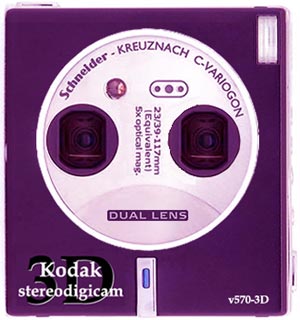
Interesting developments in the arena of digital cameras . . . Pixel Counting Joins Film in Obsolete Bin . Over ninety percent of all new cameras purchased are digital and most of the film camera manufacturers have discontinued producing them. It’s a digital future.
Likewise, industry insiders are predicting that the megapixel count wars may be over as seven to eight megapixels seem good enough for the bulk of printing options . . . albeit, I suspect we’ll see things continuing to move up well into the fourteen and fifteen megapixel range before it finally really settles down and by that time we’ll probably have some really nice Medium Format quality digital cameras for professionals.
Some developments of particular interest is Kodak’s new V570 digicam which sports two lenses, a wide angle and a telephoto to give folks choices of format when taking photos but can also be used in panorama mode. The two lenses have independant sensors. Personally, I am looking forward to them taking the next step . . . well, hoping and wishing actually as there’s no indication they’re actually thinking along these lines . . . and taking a hint from the basic camera build and the success Kodak had in the 1950s and 60s with the Kodak Stereo camera . . . who knows, maybe we’ll eventually see something along the lines of the V570-3D shown here (not a real product, just me playing with the ol’ image editor and for some wishware).

With the technology Kodak already has, it would not be difficult to re-rig the V570 to a stereodigicam which could stitch the left and right image into a single file for printing as a parallel pair or viewing in a wide variety of formats via computer. Heck, as Kodak has the no how for stereoprinting already (they used to be the single largest processors of 3D images on the planet), they could adjust their printing program kiosks to automatically print stereocard format or even anaglyph – there are already a number of freeware programs available that have this functionality so developing their own or buying someone else’s would not be difficult for a camera manufacturer or developer that wanted to push the edge on features. The first true standalone stereodigicam with two lenses of this type would certainly have an edge on the competition and would be at the forefront of what is an eventual inevitabilty in terms of consumer demand (already a lot of work is being done in terms of pushing entertainment and scientific applications of 3D technology so it makes sense that consumer digital photography would eventually catch up). Of course, in the image here, the "back" LCD is in zoom mode to allow one to pair the zoom of the view of a stereophoto in such a way to keep the window and content synched (something for fun). An actual setup would best be set so that the pairs could be printed in standard 4X6 or 5X7 sizes with stereoscopes offered both in deluxe and quickie cheap models (I tend to load fifty or more stereoprints in my Loreo deluxe viewer and happily take the prints out as I view in sequence).
As demonstrated by independant and dual functionality of the V570, the stereodigicam could have both paired stereo 3D photography function as well as a single lens traditional monophotography function as well as panorama functionality. Actually, the paired lenses could have both fixed focus and paired telephoto options (my twin rig fo Sony V-3 cameras has dual zoom capabilities and a single housed setup would have even better opportunities to synch zoom (or just drop the zoom function as in most traditional stereocameras if one needs an easier solution).
Pipe dream? Maybe, but a nice one.
See more on the actual Kodak V570 here.
All the best,
Brian







1 comment for “New Stirrings in the Way of Digicams and Whatnot . . .”